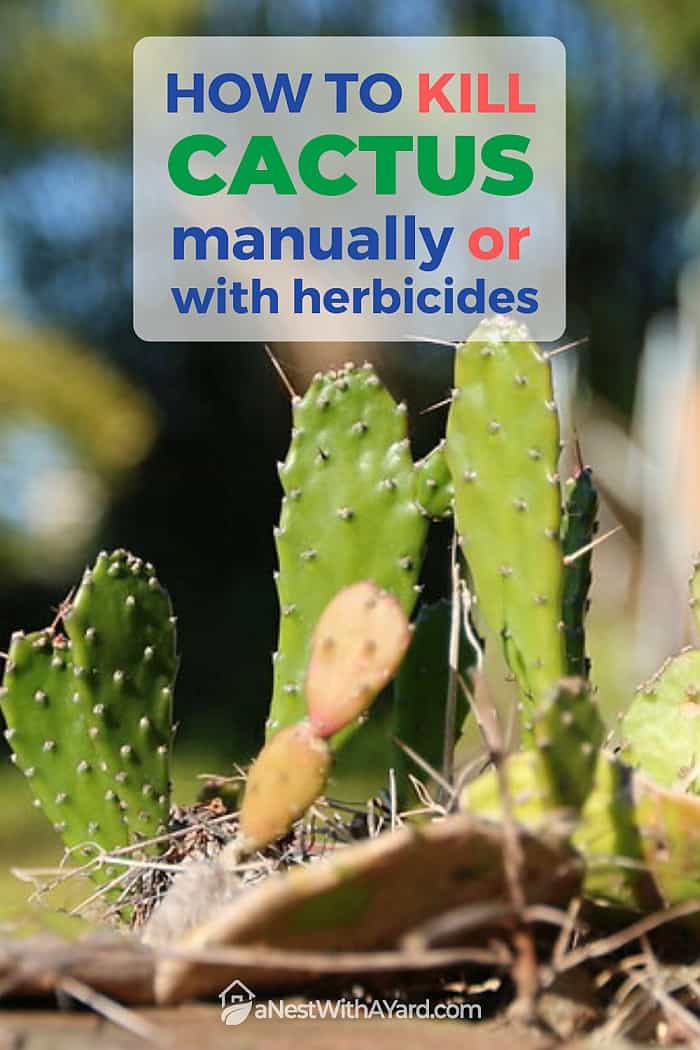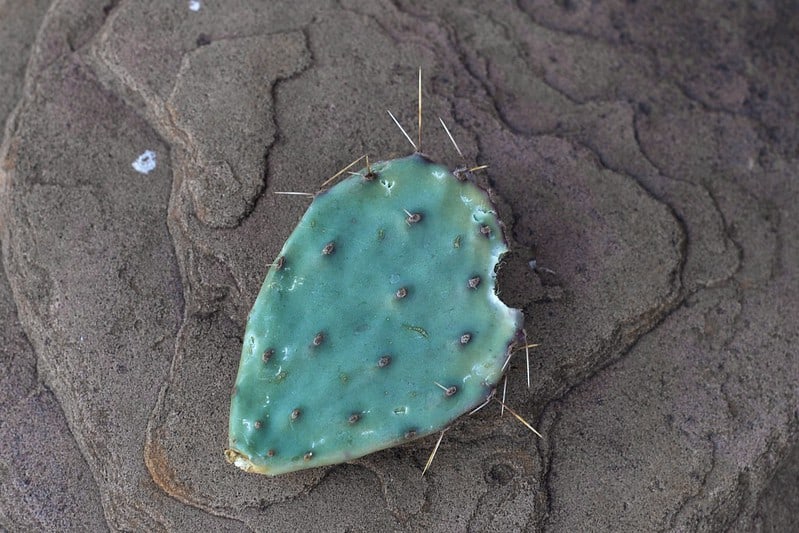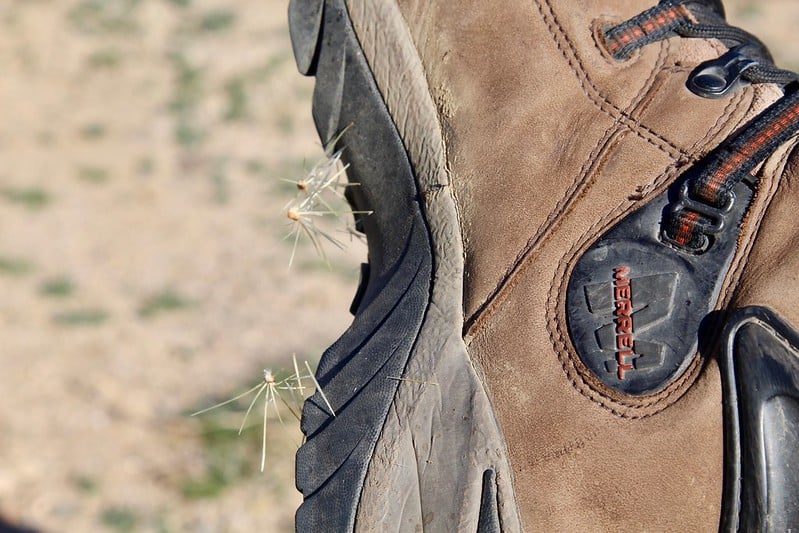How to kill cholla cactus: Mix three parts diesel oil, one part 2,4-DP, and 20 parts of water to kill cholla cacti. Wear safety goggles when applying this solution, as 2,4-DP can cause severe eye irritation. A gallon of this solution can kill up to 20 cholla cacti.
Contents
Cacti Are Stubborn
I used to have a prickly pear cactus in my backyard. After trying to cut it back, I discovered that I didn’t know how to kill cactus. New cacti grew wherever severed pieces had landed!
If you’re in a situation like mine, don’t fret. I eventually got rid of my cactus patch, and I wrote this article so you could do the same without getting poked.
How To Remove A Cactus Manually
Supplies
- A shovel
- An ax or chainsaw (for large cacti)
- Pruning shears (for small cacti)
- A garden hoe (optional)
- Thick gloves
- A long-sleeved shirt
- Long pants
- Gardening boots
- Protective goggles
- One or more thick cardboard boxes
- Tweezers
- A magnifying glass
- Salad tongs
Steps
To remove a cactus manually, follow these steps.
- Dress Appropriately
Before you do anything else, put on protective clothing. Wear a long-sleeved shirt, long pants, gardening boots, and thick gloves like the ones in this article about the best gardening tools. It’s wise to also wear protective goggles, especially if you’ll be cutting a large cactus.
- Cut The Cactus With An Axe, Chainsaw, Or Pruning Shears
An ax or chainsaw will work better for a large cactus, whereas pruning shears, like these, will suffice for a small cactus. Starting from the top of the cactus, cut off a little at a time until you reach the soil line. Don’t cut it from the base or it might fall on you!
A garden hoe is useful for gathering the severed pieces together. Using salad tongs, put them in a thick cardboard box. If you leave any on the ground, they may grow into new cacti. - Cut The Main Root
With a shovel, dig about 2-4 inches (5-10 centimeters) into the soil. When you see the main root, chop through it with the shovel or ax.
- Dig Up The Roots
Dig up as much of the root system as you can, being careful not to step on any spines that could go through your shoes. Put the root pieces in a cardboard box, as these, too can grow into new plants.
(Image credit: flickr.com) - Remove Needles From Your Clothes And Shoes
Check your clothes, gloves, and shoes for cactus needles. If you find any, pull them out with tweezers and put them in one of the boxes containing cactus pieces. You may need a magnifying glass to see some of the needles.
( Image credit: flickr.com ) - Dispose Of The Boxes Carefully
Dispose of the piece-containing boxes immediately. If the cardboard boxes become soft and decompose, the cactus pieces inside might root themselves in the ground.
Be considerate towards garbage crews who might poke themselves on the pieces. This could happen if the boxes get wet or if you don’t seal them thoroughly.
If you expect a garbage crew to load them into a truck by hand, seal the boxes with tape and put them in a garbage can. However, the best place for the boxes is in a dumpster or trash can that will be emptied by a machine.
How To Get Rid Of Cactus With Herbicides
Unfortunately, this section’s topic is too complicated for step-by-step instructions. Due to the following reasons, I recommend consulting an expert for DIY advice or hiring a licensed professional to apply herbicide for you.
Every Cactus Species Is Different
According to Dr. Barron Rector of the Texas A&M AgriLife Extension Service, the cactus family has over 1,400 species. As a result of this diversity, he says there’s no method, herbicide, or homemade cactus killer that works on all cacti.
Based on this, different cacti might also require different concentrations or application methods for the same herbicide.
Each Herbicide Has Health And Environmental Risks
Herbicides that kill cacti can harm your health or the environment to varying degrees. Some of them are fairly safe to apply cautiously, whereas others can’t be used without a license. Here are some cactus-killing herbicides and the risks they present:
Picloram
Picloram is recommended by the Texas Agricultural Extension Service for prickly pear, tasajillo, tree cholla, and dog cacti. It works by mimicking auxin, a plant growth hormone. Treated plants grow uncontrollably until they die.
Herbicides containing picloram can’t be applied without a license in the United States. And even though it works, picloram can take two to three years of repeated applications to completely kill a cactus. It can also remain active for months or years after it’s applied, harming more picloram-sensitive species.
Spraying a cactus with picloram may kill nearby plants, including trees. Worse, it can sink two meters into the soil or travel one kilometer on land, enabling it to harm your neighbors’ plants or contaminate water.
According to the Oregon Health Authority, repeated consumption of water with picloram levels over 500 parts per billion can cause damage to your central nervous system, liver damage, diarrhea, weakness, and weight loss.
Chronic exposure to picloram can also cause liver damage and weight loss in other mammals.
Though using picloram on a few cacti won’t cause this much contamination, each application in your local area increases the risk.
Some formulations of picloram are highly toxic to inhale, and some can cause severe eye damage in their liquid form.
2,4-DP
Another auxin imitator, 2,4-DP also kills plants by making them grow uncontrollably. Environmentally, 2,4-DP is much safer than picloram because its soil half-life is 7 to 10 days.
You do not need a license to buy or apply it in the United States, although laws may vary by state.
However, 2,4-DP may harm your endocrine system and immune system. For example, normally, there is a certain type of protein that carries sex hormones through your blood. Research from the Netherlands found that 2,4-DP could displace these hormones.
Additionally, a University of Missouri study found a strong correlation between high 2,4-DP levels and low sperm counts, high abnormal sperm numbers, and testicular atrophy. Meanwhile, a study from the University of Minnesota revealed that it can imitate estrogens in breast cancer cells.
2,4-DP can be more or less toxic depending on its formulation. Acid and salt formulations cause severe eye irritation, whereas ester varieties don’t.
You can safely use 2,4-DP by following the instructions on the label and wearing protective clothing. However, make sure it’s the right herbicide for your cactus and that you know how to apply it to your type of cactus.
Fluroxypyr
Like the other herbicides in this section, fluroxypyr imitates auxin. It is not a restricted-use herbicide in the U.S., however, laws may vary by state.
There is not much information on how fluroxypyr affects mammals, although some mammal studies have shown that it can cause kidney damage. However, it’s likely that different formulations of fluroxypyr have different effects.
Additionally, though it’s rapidly absorbed by the body through ingestion, it isn’t clear how well fluroxypyr is absorbed through the skin. To be on the safe side, always wear protective clothing when applying herbicides.
When sprayed, fluroxypyr can kill nearby plants if it drifts away from the application site. It can harm some wild animals, especially the eastern oyster. It’s best not to use it near water systems.
Hexazinone
Unlike other herbicides in this section, hexazinone works by inhibiting photosynthesis. It is not a restricted use herbicide in the U.S., although laws may vary by state.
Because it’s water-soluble and doesn’t bind well with soils, hexazinone can travel laterally up to 100 meters, potentially contaminating water supplies or killing ecologically important species such as algae.
In soil, hexazinone has an average half-life of 90 days. However, it can persist in runoff water six months after application.
Hexazinone can cause severe eye damage, so wear safety goggles if you use it. Lab animals who have inhaled hexazinone have suffered damage to the linings of their noses and throats, so it’s also a good idea to wear a breathing mask or respirator.
Hiring Someone May Be Cheaper Than DIY
Rather than buying a full container of herbicide and only using a little, it may be more cost-effective to let a professional apply his or her own. This is especially true for pricier herbicides like Velpar, DuPont’s trade name for hexazinone.
How To Get Free Cactus Herbicide Advice
Call Your Regional Extension Service
In the U.S, you can get free expert gardening advice through the Cooperative Extension System. The Old Farmer’s Almanac has made it easy to find your local extension office by simply clicking on your state.
Call Or Visit A Garden Nursery
Many garden nurseries employ horticulturalists who might be happy to share their expertise.
And That’s How To Kill Cactus
I wrote this article because an unwanted cactus may seem too pokey to remove. What a relief it is that you can kill it safely with the right methods!
Remember to protect yourself against the spines, and don’t leave pieces on the ground! If you decide to use herbicide, either hire a professional applicator or make sure you know what you’re doing.
Have you enjoyed my guide on how to kill cactus? If you have, please share it. Please also share your thoughts and concerns in the comments.
If you live in a desert area, here are some pictures with ideas on what to do with your cleared space.
If you have other dangerous or invasive species to kill, check out this post about how to get rid of pokeweed.





I sure appreciate your article, we have 5 acre’s and cholla cactus has become a problem the past 15 years do to pack rats spreading them and we now have a cholla cactus nest in our fifth wheel basement, were going after the pack rat problem but needed a idea on how to effectively clean the nasty nest efficiently in the basement, that’s how I stumbled on your article, I googled if it would be safe to use a blower with a vacuum mulcher option and your article came up so I will definitely be working on the cacti around the 5 acres as well. Thank you very much for the wonderful advice here!
thanks for the kind words Ethel! Good luck!